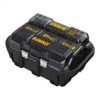Dewalt DCB116 Instruction Manual - Page 4
English - charger
 |
View all Dewalt DCB116 manuals
Add to My Manuals
Save this manual to your list of manuals |
Page 4 highlights
English • An extension cord must have adequate wire size (AWG • Do not disassemble charger; take it to an authorized service or American Wire Gauge) for safety. The smaller the gauge center when service or repair is required. Incorrect reassembly number of the wire, the greater the capacity of the cable, that may result in a risk of electric shock, electrocution or fire. is 16 gauge has more capacity than 18 gauge. An undersized cord will cause a drop in line voltage resulting in loss of power and overheating. When using more than one extension to make up the total length, be sure each individual extension contains at least the minimum wire size. The following table shows the correct size to use depending on cord length and nameplate ampere rating. If in doubt, use the next heavier gauge. The smaller the gauge number, the heavier the cord. • Disconnect the charger from the outlet before attempting any cleaning. This will reduce the risk of electric shock. Removing the battery pack will not reduce this risk. • NEVER attempt to connect 2 chargers together. • The charger is designed to operate on standard 120V household electrical power. Do not attempt to use it on any other voltage. This does not apply to the vehicular charger. • This Class B digital apparatus complies with Canadian ICES-003. Minimum Gauge for Cord Sets • Changes or modifications not expressly approved by DeWALT Volts Total Length of Cord in Feet (meters) could void the user's authority to operate the equipment. Ampere Rating 120V 25 (7.6) 50 (15.2) 100 (30.5) 150 (45.7) • This device complies with Part 15 of the FCC Rules. Operation is 240V 50 (15.2) 100 (30.5) 200 (61.0) 300 (91.4) subject to the following two conditions: More Than 0 6 10 12 Not More Than 6 10 12 16 AWG 18 16 16 14 18 16 14 12 16 16 14 12 14 12 Not Recommended • Do not place any object on top of charger or place the charger on a soft surface that might block the ventilation slots and result in excessive internal heat. Place the charger in a position away from any heat source. The charger is ventilated 1) This device may not cause harmful interference, and 2) This device must accept any interference received, including interference that may cause undesired operation. NOTE: This equipment has been tested and found to comply with the limits for a Class B digital device, pursuant to Part 15 of the FCC Rules. These limits are designed to provide reasonable protection against harmful interference in a residential installation. This equipment generates, uses and can radiate radio frequency energy and, if not installed and used in accordance with the instructions, may cause harmful interference through slots in the top and the bottom of the housing. to radio communications. However, there is no guarantee that • Do not operate charger with damaged cord or plug. • Do not operate charger if it has received a sharp blow, been dropped, or otherwise damaged in any way. Take it to an authorized service center. interference will not occur in a particular installation. If this equipment does cause harmful interference to radio or television reception, which can be determined by turning the equipment off and on, the user is encouraged to try to correct the interference by one or more of the following measures: 2













